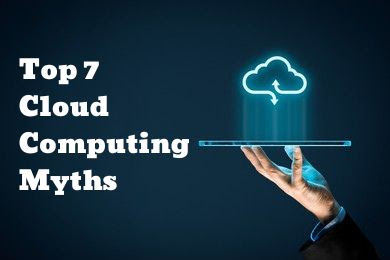Myths can be fun and entertaining when they involve the exploits of ancient gods and heroes. However, the laughter quickly ends when a myth prevents the success of an organization or its IT. The amusement stops quickly, however, when a myth hampers IT or enterprise success.
A widely used technology, cloud computing provides scalable computing resources at lower costs. Businesses can access data from any computer or location in the world as long as there is a working internet connection. It provides a platform for the distribution of software and services as well as remote access to work-related data. Using efficient development infrastructures, developers can easily get their applications developed. You will have to decide between Software as a Service (SaaS), Infrastructure as a Service (IaaS), or Platform as a Service (PaaS) if you use cloud computing services. Today, we will be busting some of the popular myths associated with this technology.
Is your organization using the cloud to its full advantage? If not, the following 7 myths could be preventing it.
1. Switching to the cloud automatically saves money
This is often true, but only when planned carefully. According to Paul Sussex, Americas financial services principal at financial and business consulting firm EY, "The cloud can be more cost-effective due to its elastic nature, but a cloud migration and a strong cloud-based business require upgrades and work to an organization's applications and base computers to fully benefit from those savings."
Cost is just one of the dimensions to consider when thinking about cloud. Jonathan Stone, CTO and COO of the IT consulting company Kelser, suggests that it's also crucial to consider the context of the overall business strategy. "For instance, running workloads in the cloud may be worth a cost increase if it helps achieve a business goal. Even though cloud computing is more expensive than on-premises, it may be a business growth enabler and thus be justified as an investment if the primary goal is business growth, which depends on the capacity to scale up quickly.
2. A stable IT infrastructure can be layered with cloud computing.
Cloud computing is nothing less than a major platform shift, profoundly changing application capabilities in terms of agility, functionality, scalability and cost, Golden says. Therefore, he says, "failing to migrate the entire IT estate to the cloud runs the risk of falling behind rivals more dedicated to thriving in the digital age."
Cloud computing is analogous to manufacturing’s transition from handwork to assembly lines. Manufacturers who didn't switch to the new manufacturing model found it impossible to compete on productivity and price; the majority were quickly driven out of business. Similarly, failing to commit to cloud computing risks maintaining outmoded IT practices, placing the enterprise at a competitive disadvantage.
3. The cloud is difficult to audit
One of the most pervasive myths is that cloud data can’t be audited as effectively as physical servers, which can be seized and tagged or placed into evidence bags. In fact, Marina Nitze, who served as the U.S. Department of Veterans Affairs' chief technology officer from 2013 to 2017, claims that with the right tools, cloud-based audits can be carried out much more effectively. “Spending time with those who actually conduct audits day to day and walking them through how they can use tools … and how these tools can alleviate some of the current pain points in their jobs, can help bust this myth,” she notes.
4. The cloud is an IT job killer
When an enterprise transitions on-prem services to the cloud, the IT administrator does not automatically lose his or her job. Most often, the transition results in the administrator's role changing to that of a trusted advisor and facilitator of technical solutions. In most cases, the changeover transforms the administrator’s role into one of a trusted advisor and technical solutions facilitator. Doug Barbin, principal and cybersecurity practice leader at Schellman & Co., a security and privacy compliance assessor, adds that "more importantly, while the cloud provider may manage the network and data center security, [customers] are still on the hook for administering their own logical access."
5. Cloud runs automatically
Are you familiar with the fact that the cloud runs itself? Do you know that the cloud operates on its own? Well, it's just a myth. If you've heard this, you should be aware that the cloud is not self-running and that everything from the infrastructure layer up can be automated. Therefore, to handle and manage the tools used in cloud computing operations, you need professionals with experience and understanding.
6. BYOD is expensive.
If you are associated with this technology or planning to pursue Cloud Computing Online Courses, you are supposed to know that BYOD is not expensive at all. Strategies involving BYOD (bring your own device) don't come at a high cost. Without constructing any infrastructure, one can access the cloud, which is secure. It follows the “pay-as-you-go” model, which reduces expenses.
7. Clouds hurt the environment.
Large-scale businesses run their own data centers to store and protect customer data. Power consumption for lighting, cooling, and maintenance is high in these establishments. However, the hosting providers invest in the latest power-efficient technologies.
